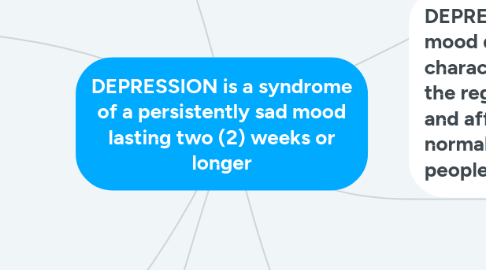DEPRESSION is a syndrome of a persistently sad mood lasting two (2) weeks or longer
por Shayna Salvo


1. Meet physiological needs as evidenced by appropriate expression of feelings, identification of options, and use of resources.
2. Ask patient whether he thinks about death or suicide. Signal an immediate need for consultation and assessment. Risk of suicide is higher with lifting of depressed mood.
3. It is accompanied by other problems like feelings of guilt, helplessness, or hopelessness, poor concentration, sleep disturbances, lethargy, appetite loss or weight gain, anhedonia, loss of mood reactivity, and thoughts of death.
3.1. Genetic factor. Two-three times more common in people with first-degree relative with the disorder.
3.2. Biological factors. Primary defect sites at prefrontal cortex and basal ganglia. It may also involve serotonin, neuroendocrine, and hypothalamic-pituitary-adrenal (HPA) regulation systems. May also be associated with abnormal cortisol levels.
3.3. Psychosocial factors. There is an unclear relationship between psychological stress, stressful life events, and depression onset.
3.4. Pharmacologic factors. Prescribed drugs for certain medical and psychiatric conditions can cause depression. Some of these medications include antihypertensives, psychotropics, antiparkinsonian drugs, oral antidiabetics, steroids, and chemotherapeutic agents.
4. Implementation
4.1. Assume active role in initiating communication. This can be done by sharing observation of patient’s behavior, speaking slowly and allowing ample time for him to respond, encouraging him to talk and write down feelings, and by providing a structured routine which may include noncompetitive activities.
4.2. Provide for patient’s physical needs. Assist with self-care and personal hygiene. Encourage patient to eat. Give warm milk or back rubs at bedtime to improve sleep. Plan activities for times when the patient’s energy level peaks
4.3. Avoid feigned cheerfulness, but don’t hesitate to laugh with him and point out the value of humor.
5. Evaluation
5.1. Patient’s ability to assess current situation accurately.
5.2. Patient’s ability to identify ineffective coping behaviors and consequences.
5.3. Verbalization of awareness of own coping abilities and of feelings congruent with behavior.
6. DEPRESSION is classified under mood disorders which are characterized by disturbances in the regulation of mood, behavior, and affect that go beyond the normal fluctuations that most people experience.
6.1. Nursing Management
6.1.1. Subjective cues. Include verbalization of inability to cope or ask for help, sleep disturbance and fatigue, abuse of chemical agents, and reports of muscular or emotional tensions, and lack of appetite.
6.1.2. Objective cues. Include lack of goal-directed behavior or resolution of problem; inadequate problem solving, decreased use of social support, inability to meet role expectations/basic needs, and destructive behavior toward self (e.g. overeating, smoking/drinking, overuse of prescribed/OTC medications, and illicit drug use)

